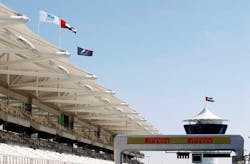Yas Marina from a tire point of view
The penultimate round of this year’s Formula One World Championship at the Yas Marina circuit presents its own unique challenges for the tires. The 55-lap race takes in a total of 189.738 miles from dusk to nightfall, meaning that track temperatures tend to fall and then stabilize. This affects tire performance in terms of pace, degradation and wear, making it different at the end of the race compared to the beginning. Here are some of the key points of the Abu Dhabi circuit from a tire point of view.
The track:
The first corner is the start of a flowing sequence of bends. The car is subjected to sideways accelerations of 4G, with the outside tires guaranteeing grip along with the best possible roadholding at speeds of 155mph.
Throughout the longest straight of the lap, the structure of the tire is challenged due to the high speeds reached with full throttle maintained for around 15 seconds. The aerodynamic downforce generates a loading of 1764 pounds, entirely absorbed by the tire structure, which at the same time has to soak up any bumps and imperfections in the track surface.
For Turn 11, the cars go from 186mph to 56mph in 120 yards. This is a 5G deceleration, taking the drivers into a slow series of esses that have to be driven with maximum precision.
The final section of the lap requires an optimal balance from the car. A sequence of curves progressively heats up the tread pattern. The tire temperature can reach 266° Fahrenheit while still ensuring the highest possible levels of grip, durability and car control that are vital for Abu Dhabi’s asphalt.
Testing prototype tires:
Once more, the Abu Dhabi circuit will be an important proving ground for Pirelli, with the track providing an arena for the Italian company’s latest range of development tires: just as it did last year when the P Zero tires were seen on a contemporary Formula One car for the first time.
While the season has been taking place, Pirelli has also carried out 10 days of private testing with test driver Lucas di Grassi and a Toyota TF109 that has been modified to reflect the latest technical and aerodynamic regulations. The tests took place over four circuits – Istanbul, Barcelona, Jerez and Monza – covering on average 435 miles per day. The initial results of that work will be seen on Friday and during the young driver test.
The tests have concentrated on refining the latest evolutions of the P Zero tires that will be seen next year, using a combination of computer simulation, driver feedback, and data analysis.
A new tire is first virtually simulated using computer-based mathematical models by the research and development division in Milan, before a series of bespoke physical prototype tires are made in the Pirelli factory at Izmit in Turkey. Before these prototypes are put onto a car, they are subjected to a number of machine tests in Milan that push the tire’s limits way beyond the usual parameters. Only then does it take to the track.
During a tire test, the test driver tries out each new tire for a set number of laps but in between runs he will constantly return to a reference tire: in this case, the existing compounds that have been used this year. This means that Pirelli’s engineers have a consistent base from which to work, and they will also know if performance has been influenced by any other factors apart from the new tire that is being assessed.
As well as the raw data that is collected during a tire test – such as temperature, loading and lap times – the driver gives his subjective impression of the tire, taking into account warm-up time, driveability and handling precision.
More often than not, the driver’s impressions are backed up by the data, and often he has an idea as to how the tire could be improved further. Using the conclusions reached, the engineers can adjust the compound and structure to achieve the desired results – which can then be tested and verified again with a different prototype tire. With just 10 days of official testing allowed prior to the start of the 2012 season, the work carried out by di Grassi and the test team is vitally important.
Pirelli’s motorsport director Paul Hembery commented: “The pace of development in Formula One is phenomenal and so it did not take the teams very long at all to fully understand our tires and make the most of their potential. This means that in a way we have had to constantly reinvent ourselves in order to keep on pushing the envelope and next year’s tires represent the next step, with yet more performance. The feedback and information that we obtain over the Abu Dhabi weekend and test will be very important as we continue to develop our 2012 range of P Zero tires.”
